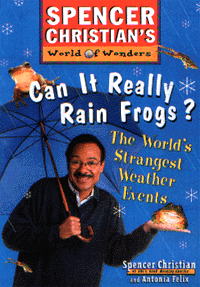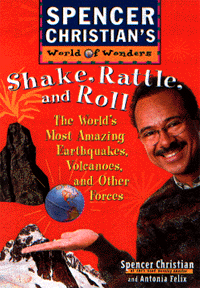|
It's No 'Wonder' Kids Love These Books!
World of Wonders, a new series by Spencer Christian of ABC-TV's "Good Morning America", uses amazing stories and fascinating facts to introduce the science behind natural phenomena.

Did you know that a tornado once sucked a document out of a locked safe (the door never opened) in Murphysboro, Ill., and transported it 125 miles? Or that it once rained snails in Chester, Pennsylvania? Or that an earthquake can be predicted by cockroaches scrambling around as if they can't decide where to go?
A multitude of such fun facts -- and a thorough explanation of the science behind them -- can be found in Spencer Christian's World of Wonders, a riveting new series for children ages 8-12.
Using fascinating truths and eyewitness accounts, "Good Morning America" weather forecaster Spencer Christian, along with children's author Antonia Felix, expertly guides readers through the formidable forces of nature, from untwisting the myths of tornadoes to shaking out the facts about plate tectonics, in the first two books of the series, Can It Really Rain Frogs? The World's Strangest Weather Events and Shake, Rattle, and Roll: The World's Most Amazing Earthquakes, Volcanoes, and Other Forces.

Both books keep the reader engaged with illustrations, anecdotes, easy-to-understand explanations and glossaries. Both volumes contain several hands-on activities as well, all using simple materials you're likely to have on hand in the classroom or at home. For example, to illustrate the properties of snowflakes (did you know they're not all six-sided crystals?), turn your kids into snowflake gazers with black felt or cardboard (chilled to keep the flakes from melting) and a magnifying glass. Other weather-related activities include creating a cloud, making a barometer, and using a strand of hair to measure relative humidity. Shake, Rattle, and Roll tells kids how to create invisible shock waves strong enough to blow out a candle and offers a tasty way to demonstrate the properties of lava with fudge.
And while it's not advocated directly, the books can certainly be an inspiration for writing activities of all kinds. For example, Christian's own accounts of lightning knocking his parents to the floor, in separate incidents during the same storm when he was a child, and of living through Hurricane Hazel when he was 7 are sure to prompt tales of the worst natural disasters your students have been through.
The series will continue with What Makes the Grand Canyon Grand? The World's Most Awe-Inspiring Natural Forces, due to be released in February 1998, and Is There a Dinosaur in Your Backyard?: The World's Most Fascinating Fossils, Rocks, and Minerals, slated for release the following spring.
If the first two books are any indication, the entire series will be a "must have" for schools and libraries. The books are as entertaining as they are educational, and they are sure to delight teachers and parents as well as children. The content carried me along like the 75-mile-per-hour winds of a hurricane (as opposed to the 39 to 74 mile-per-hour winds of a tropical storm), and by the time I got to the facts about Vesuvius and Pompeii, I'd been buried in these books for two hours!
SOME AWE-INSPIRING FACTS
FROM WORLD OF WONDERS
- Sand dunes are built up by desert winds that blow from one direction over a long period of time. Some dunes, reaching several stories high, slowly move across the desert landscape. In Iran and Algeria, some become as tall as skyscrapers!
- Tornadoes have been reported to, among other bizarre things, pluck the feathers from chickens, drive wooden planks through steel, and tattoo people for life by driving sand and grit deep beneath their skin.
- Lightning courses through a body at speeds of 90,000 miles per second -- so fast that it often doesn't leave permanent injury. (But this doesn't mean you shouldn't take cover during a storm. About 100 people are killed and another 500 are injured by lightning every year.)
- Sometimes a cloud filled with hot gas, ash, pumice and bits of rock is shot out of a volcano like hairspray shot from an aerosol can. This cloud, called a nue ardente, races down the mountain and across the land at speeds up to 300 miles per hour. The cloud can be up to 1800 degrees Fahrenheit, and it kills everything it passes. In 1902, such a cloud erupted from Mt. Pele in Martinique (in the Caribbean), instantly killing all 30,000 people in the town.
- The largest volcano in the solar system is on Mars! Olympus Mons is an extinct volcano that spreads 370 miles in diameter and rises 15 miles above a rocky plain. This volcano is almost five times larger than the biggest volcano on Earth, Mauna Loa.
- A 1976 earthquake in Tangshan, China, killed 255,000 people and seriously injured another 600,000 in the city and the surrounding area. Yet just 71 miles away in Qinglong County, where more than 180,000 buildings were destroyed, only one person died -- the victim of a heart attack. How did this happen? County officials had taken action several days before the quake hit. After reports that weasels and rats were moving around in broad daylight, unafraid of humans, and that natural spring water had become muddy -- signs to some that forces were at work below the earth's surface -- officials evacuated 60 percent of the population. Hundreds of thousands of people were saved by paying attention to nature.
Can It Really Rain Frogs? The World's Strangest Weather Events and Shake, Rattle, and Roll: The World's Most Amazing Earthquakes, Volcanoes, and Other Natural Forces, by Spencer Christian and Antonia Felix and published by John Wiley & Sons Inc., are available in paperback at your local bookstore for $12.95 or by calling 1-800-225-5945 (in Canada, 1-800-567-4797).
Article by Colleen Newquist
Education World®
Copyright © 1997 Education World
09/22/1997
|